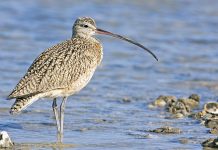As its name suggests, the Western Yellow Robin (Eopsaltria griseogularis) represents the Eastern Yellow Robin in Western Australia. It is also known as Grey-breasted Robin. It belongs to the Australasian Robin family, Petroicidae. It has similar habits and occupies much the same niche, although frequently more open woodland and mallee. Some ornithologists treat the two as races of one another. This question is difficult to resolve satisfactorily because the two species are geographically isolated and cannot be shown to be interfertile or not under natural conditions.
The Western Yellow Robin differs mainly in its white throat and broad grey breastband, which may have evolved when its ancestors became separated from eastern stocks during cold, dry epochs in the past. Western Yellow Robins move about in the scrubby covers of forests and woodlands. They remain still or drop to the ground to pick up an insect, sometimes eating it there, and then rise again to a vantage point. The Western Yellow Robin is frequently found alone or in pairs, and less generally in small groups—most likely a mated pair, social, and helper birds.

Their diet consists mainly of ground insects, especially ants and spiders; other insect food includes moth larvae, beetles, small cockroaches and wasps. When the Western Yellow Robin perches either by clinging sideways low down on a tree trunk, or in the more conventional way on a branch, it often jerks its tail up and down and flicks its wings. The fight is short, even when the bird has been distributed rapidly and undulatingly, and includes short glides to a perch.
Western Yellow Robin call is soft, repeated piping notes on same pitch, by both sexes. The song is explosive chip-chip or k’chip by male, in alarm or territorial advertisement. Moreover, there is a series of trilled whistles at dawn.
The Western Yellow Robin usually builds its nest in a fork of either a standing or a fallen tree, particularly a young tree with strips of bark hanging from the branches. Using cobwebs, the bird attaches similar bark strips, about 110 mm long, to the rim; the result is a masterpiece of camouflage.
The female does the incubating and brooding, and the male feeds her. Both birds feed the young in the nest and for a while afterwards. A pair may raise more than one brood a season. This species sometimes breeds co-operatively; other individuals have been recorded helping the parents to feed the chicks.
A parent bird often feigns a broken wing when an intruder approaches its nestlings. It ruffles up its feathers and appears to make painful progress along the ground, with one wing trailing. In the non-breeding season, Western Yellow Robins are sometimes seen in the mixed feeding flocks of small insect-eating perching or song birds. Destruction of large tracts of their habitat for agriculture has probably brought a decline in their numbers over the past few years.

The size of Western Yellow Robin is about 145-155 mm in length. Both sexes are similar. Upper parts plain mid-grey, dull citrine to bright yellow on rump. Wings and tail are darker browner grey, with concealed white wings barring the base off light feathers and narrow white tip to tail. Face is mid-grey; lores are dusky. Throat is white; upper breast broadly grey; lower breast to undertail bright yellow. Eye dark brown. Bill black. Feet are dusky. Immature birds are duller, molting from juvenile plumage in the first autumn. Juveniles brown above coarsely mottled and streaked cream-white; white below coarsely mottled brown on throat and breast, with pale mouth streak.
Western Yellow Robin lays usually two eggs of apple green to pale yellow-green color. It is marked with browns, especially at larger end; oval shape, about 20 x 1 5 mm. The incubation period is about 15-16 days, for females.
Nesting and breeding occur in July-December, rarely January. Nest a beautiful cup of bark and coarse grass, sometimes dry leaves, bound with cobweb. Nest is outside by cobweb and hangs down to about 110 mm from the rim; 63 x 31 mm inside, lined with finer fiber. The nest is built in the fork of a tree, particularly in a younger tree with bark strips hanging from the forks; up to 8 meters from the ground.
As far as distribution concerned, it is found in ranges north to Peron Peninsula, Western Australia, and in patches east to Eyre Peninsula, South Australia. Common to fairly common singly, in pairs or family parties in forest and woodland with scrub cover. Some movement to more open areas, lowlands or coasts in winter, and some local movement dictated by food supply. There are two races; one in extreme southwest of Western Australia; and the other, duller-backed, through Western Australian wheat-belt to Eyre Peninsula, SA.
Read More: The Flame Robin (Petroica phoenicea)







